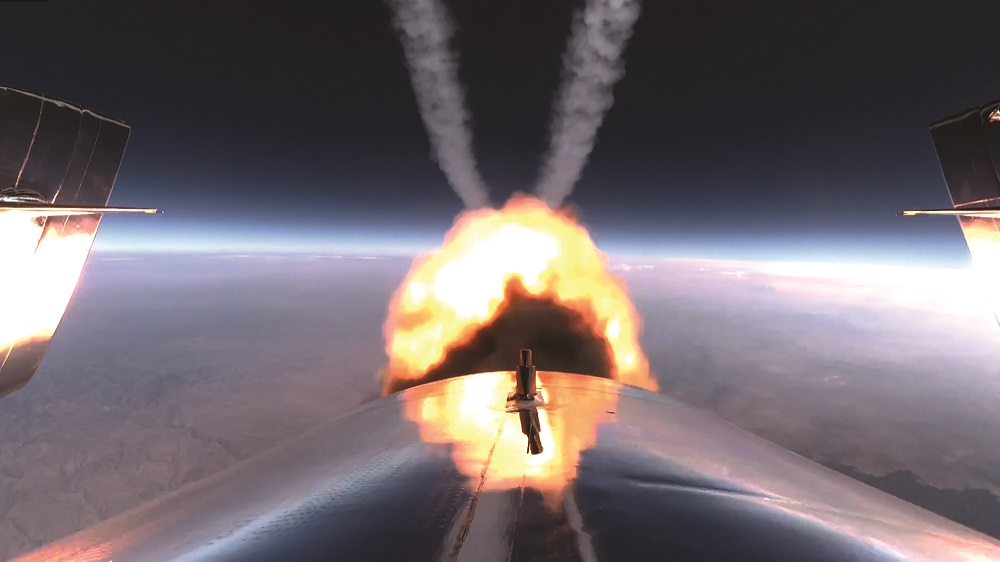There’s no such thing as a free launch — especially when it comes to suborbital joy rides
Whether or not you agree with Elon Musk that we need higher volume and lower cost access to space so that a small portion of humanity can flee our imperiled planet and become planetary refugees, at least he has a plausible justification (albeit one that deserves scrutiny and debate) for undertaking major industrial activities and launch operations that inject thousands of tons of carbon and other greenhouse gasses (GHG) into the atmosphere.
The backdrop, though, is that we are reeling from multiple and recurring extreme weather events caused at least in part by climate change wrought by human activities. So, how do Richard Branson, Jeff Bezos, and to some extent, Elon Musk, justify their extensive, carbon-generating activities? Space Tourism!
I spent a long and interesting professional life in the space industry in a variety of roles, from selling satellites and launch services, to promoting companies that launched constellations of LEO and GEO communications satellites, to opening the new market for satcom services on aircraft. I was always confident that the mission of the civilian satellite industry — to increase knowledge, awareness, and communications among people everywhere — was worthy, and that this mission justified the known environmental costs of civilian space activities.

Now, based on evolving awareness about the environmental impact, I’m not at all sure. The perilous state of our atmosphere is front page news, and it seems increasingly challenging to change human behavior significantly enough, and quickly enough, to avert major disaster caused by global climate change. We are already living in a period with a far higher incidence of extreme weather events — storms, floods, heat waves, fires, etc. — and the link to climate change is clearer by the day.
The carbon footprint and other GHG contributions from the development, construction and operation of space launch systems is massive. As with many human activities, we are only beginning to quantify the total impact of this industry, but it is not impossible to do so; recall the Total Cost of Ownership (TCO) analyses frequently conducted by companies to justify their investments. For launch services, TCO includes the environmental impact of extraction and refining of all the materials, and for developing and producing the vehicles, their support components, and their chemical fuels, plus the very visible large burning event of the launch itself. Whatever the specific analysis eventually reveals, we are talking about tons and tons and tons of atmospheric carbon. It is truly a massive footprint. I challenge the launch services providers to demonstrate otherwise.
We are long past the days when spaceflight was an indomitable challenge, so climbing the space mountain because it is there is simply not a sufficient justification for doing so in light of the known harm to those of us planning to remain on the planet.
The new human launch systems and their private company management teams offer technical and operational improvements and efficiencies, to be sure, but the underlying technologies and activities still carry huge environmental costs, which are currently passed to the public. With government historically running the show, at least we had the party ultimately responsible for addressing the environmental cost making the key decisions. Those have not always been good decisions, but government is now waking up to the issues of climate change, and while this may shift over time, government is clearly the most important mechanism we have today for structurally addressing the climate crisis.
The economic rationale for the new systems, and their pricing, are based in large part on projected larger volumes. While the start-up costs for these systems are backed by massive private fortunes that can distort the economic rationale, it is clear that current pricing is not supported by demonstrable underlying demand for launch services. In fact, the “business plans” for these larger volumes are supported by optimistic revenue projections for launching constellations of communications satellites that, despite their own optimistic projections, cannot hope to compete with terrestrial services in the medium or long term, outside of the niches where satellite technologies excel: namely, broadcast, low user density two-way connectivity (remote and mobile) and Earth observation.
While other aspects of their plans may be shaky, the worst kind of “business plan” backfilling for this new generation of launch services is space tourism, a “service” for the ultra wealthy, that serves no higher purpose whatsoever, and carries very substantial environmental costs at a time of climate peril for the planet. It is very hard to see how flying billionaires, or even multimillionaires into space is filling a need that is so important that we should be adding tons of carbon and other GHG to the atmosphere so they can COMMENTARY Leo Mondale realize their childhood dreams, or effect their escape from a planet they are doing much to imperil.
Surely within the space industry we don’t need to discuss whether we believe in science or not, so we should accept the scientific consensus that the environmental impacts of atmospheric carbon and other GHG are real and getting worse. Ideologically, we can probably also agree that protecting personal freedoms that do not cause harm to others is central to our society, and arguably, to its survival. But in the case of space tourism, there IS clear and present harm to others. Indeed, if there is a poster child for where to apply a steep carbon tax, or other climate change mitigation policies, it is surely space tourism. I urge legislators and policymakers to do so at once, before this toothpaste is out of its tube.
Leo Mondale spent 35 years in the space industry, holding executive positions at Matra (now Airbus), Fairchild Space and Defense, Motorola, Iridium, and Arianespace. He most recently served as president of Inmarsat’s aviation business unit, before retiring in 2018. He lives in Portland, Maine.
This article originally appeared in the August 2021 issue of SpaceNews magazine.
